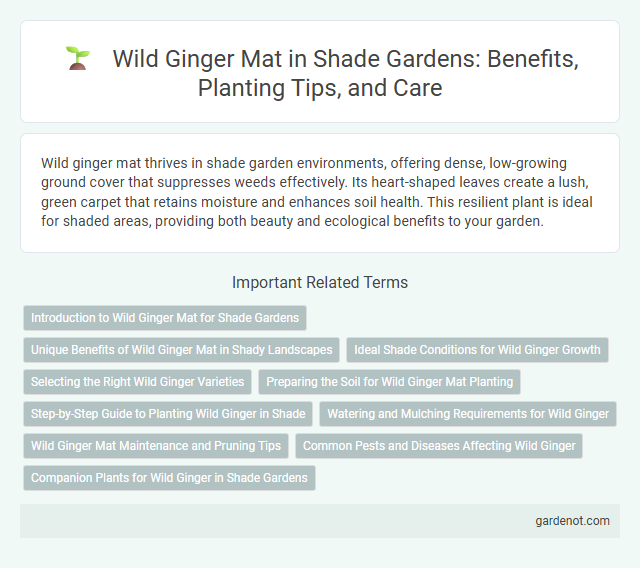Wild ginger mat thrives in shade garden environments, offering dense, low-growing ground cover that suppresses weeds effectively. Its heart-shaped leaves create a lush, green carpet that retains moisture and enhances soil health. This resilient plant is ideal for shaded areas, providing both beauty and ecological benefits to your garden.
Introduction to Wild Ginger Mat for Shade Gardens
Wild ginger mat (Asarum canadense) thrives in shade gardens, providing dense ground cover with heart-shaped, glossy leaves that suppress weeds and retain moisture. This native perennial supports biodiversity by attracting pollinators and offering habitat for beneficial insects. Its low maintenance and adaptability to various soil types make wild ginger mat ideal for enhancing shade garden aesthetics and ecosystem health.
Unique Benefits of Wild Ginger Mat in Shady Landscapes
Wild ginger mat thrives in shady landscapes by providing dense ground cover that suppresses weeds and retains soil moisture, promoting healthier plants. Its heart-shaped, aromatic leaves enhance garden aesthetics while attracting beneficial pollinators such as native bees. This low-maintenance plant also prevents soil erosion and adapts well to various soil types, making it an ideal choice for sustainable shade gardens.
Ideal Shade Conditions for Wild Ginger Growth
Wild ginger thrives best in deep shade environments where indirect sunlight mimics its natural forest floor habitat. It requires consistently moist, well-drained soil enriched with organic matter to support healthy mat formation. Partial to full shade conditions prevent leaf scorch and promote vibrant, dense foliage ideal for ground cover in shaded garden areas.
Selecting the Right Wild Ginger Varieties
Selecting the right wild ginger varieties for a shade garden enhances ground cover with lush, evergreen foliage and subtle, fragrant blooms. Varieties like Asarum canadense thrive in moist, well-drained soil while Japanese wild gingers (Asarum nipponicum) offer striking heart-shaped leaves and adaptability to different shade levels. Prioritize native species for ecological benefits and disease resistance, ensuring a vibrant, low-maintenance wild ginger mat.
Preparing the Soil for Wild Ginger Mat Planting
Preparing the soil for wild ginger mat planting involves creating a rich, well-draining, and consistently moist environment with high organic matter content, such as leaf mold or compost. Soil pH should be slightly acidic to neutral, ideally between 5.5 and 7.0, to promote optimal growth and health of the plant. Loosening the soil to a depth of at least 6 inches improves root penetration and encourages the formation of a dense, attractive ground cover in shade gardens.
Step-by-Step Guide to Planting Wild Ginger in Shade
Plant wild ginger (Asarum canadense) by selecting a well-shaded area with rich, moist, and well-drained soil to replicate its natural forest floor environment. Dig shallow holes spaced 12 to 18 inches apart, gently place rhizomes or root divisions in each hole, and cover with soil, ensuring the crown is just below the surface for optimal growth. Maintain consistent moisture and mulching to retain humidity, protect roots, and suppress weeds, promoting a dense, lush groundcover in your shade garden.
Watering and Mulching Requirements for Wild Ginger
Wild ginger mat thrives in consistently moist, well-drained soil, requiring regular watering to maintain its natural habitat's humidity without waterlogging the roots. Applying a 2-3 inch layer of organic mulch, such as leaf litter or shredded bark, helps retain soil moisture, suppress weeds, and regulate temperature fluctuations. Proper watering combined with mulching supports vigorous ground cover growth and healthy foliage in shaded garden areas.
Wild Ginger Mat Maintenance and Pruning Tips
Wild ginger mat thrives in shady garden areas with moist, well-drained soil and requires minimal maintenance beyond occasional watering during dry spells. Prune wild ginger mats in early spring to remove dead or damaged leaves, promoting healthy new growth and preventing overcrowding. Regularly dividing dense mats every few years helps maintain vigor and enhances air circulation, reducing the risk of fungal diseases.
Common Pests and Diseases Affecting Wild Ginger
Wild ginger mat (Asarum canadense) is susceptible to pests such as slugs and vine weevils, which can cause significant leaf damage and hinder plant growth. Fungal diseases like leaf spot and powdery mildew may also affect the foliage, especially in damp, shaded environments. Proper air circulation and soil drainage are essential to minimize these common threats in shade garden settings.
Companion Plants for Wild Ginger in Shade Gardens
Wild ginger (Asarum canadense) thrives in shade gardens and pairs well with companions like hostas, ferns, and trilliums, which share similar light and moisture preferences. These plants create a layered groundcover effect, enhancing soil health and supporting pollinators while suppressing weeds. Integrating wild ginger with woodland phlox and bleeding heart further enriches biodiversity and visual appeal beneath tree canopies.
Wild ginger mat Infographic

 gardenot.com
gardenot.com